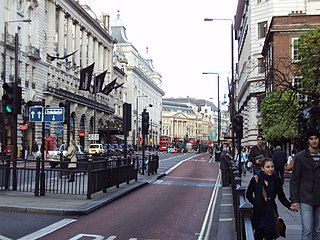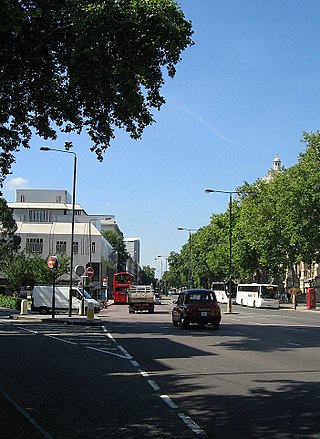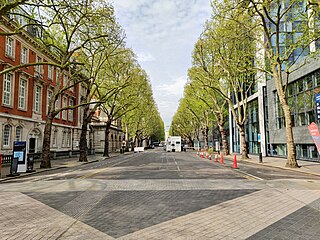
Kensington is an area of London in the Royal Borough of Kensington and Chelsea, around 2.9 miles (4.6 km) west of Central London.

The Royal Borough of Kensington and Chelsea is an Inner London borough with royal status. It is the smallest borough in London and the second smallest district in England; it is one of the most densely populated administrative regions in the United Kingdom. It includes affluent areas such as Notting Hill, Kensington, South Kensington, Chelsea, and Knightsbridge.
The Royal College of Science is a higher education institution located in South Kensington; it is a constituent college of Imperial College London from 1907 until it was wholly absorbed by Imperial in 2002. Still to this day, graduates from the Faculty of Natural Sciences at Imperial College London receive an Associateship to the Royal College of Science. Organisations linked with the college include the Royal College of Science Union and the Royal College of Science Association.

The Great Exhibition of the Works of Industry of All Nations, also known as the Great Exhibition or the Crystal Palace Exhibition, was an international exhibition that took place in Hyde Park, London, from 1 May to 15 October 1851. It was the first in a series of world's fairs, exhibitions of culture and industry that became popular in the 19th century. The event was organised by Henry Cole and Prince Albert, husband of Victoria, Queen of the United Kingdom.

Piccadilly is a road in the City of Westminster, London, England, to the south of Mayfair, between Hyde Park Corner in the west and Piccadilly Circus in the east. It is part of the A4 road that connects central London to Hammersmith, Earl's Court, Heathrow Airport and the M4 motorway westward. St James's is to the south of the eastern section, while the western section is built up only on the northern side. Piccadilly is just under 1 mile (1.6 km) in length, and it is one of the widest and straightest streets in central London.

Kensington Gardens, once the private gardens of Kensington Palace, are among the Royal Parks of London. The gardens are shared by the City of Westminster and the Royal Borough of Kensington and Chelsea and sit immediately to the west of Hyde Park, in western central London known as the West End. The gardens cover an area of 107 hectares. The open spaces of Kensington Gardens, Hyde Park, Green Park, and St. James's Park together form an almost continuous "green lung" in the heart of London. Kensington Gardens are Grade I listed on the Register of Historic Parks and Gardens.

Cromwell Road is a major London road in the Royal Borough of Kensington and Chelsea, designated as part of the A4. It was created in the 19th century and is said to be named after Richard Cromwell, son of Oliver Cromwell, who once owned a house there.

Albertopolis is the nickname given to the area centred on Exhibition Road in London, named after Prince Albert, consort of Queen Victoria. It contains many educational and cultural sites. It lies in the former village of Brompton in Middlesex, renamed as South Kensington, split between the Royal Borough of Kensington and Chelsea and the City of Westminster, and the area bordered by Cromwell Road to the south and Kensington Road to the north.

South Kensington is a district just west of Central London in the Royal Borough of Kensington and Chelsea. Historically it settled on part of the scattered Middlesex village of Brompton. Its name was supplanted with the advent of the railways in the late 19th century and the opening and naming of local tube stations. The area has many museums and cultural landmarks with a high number of visitors, such as the Natural History Museum, the Science Museum and the Victoria and Albert Museum. Adjacent affluent centres such as Knightsbridge, Chelsea and Kensington, have been considered as some of the most exclusive real estate in the world.

Sir James Pennethorne was a British architect and planner, particularly associated with buildings and parks in central London.

Kensington Road is a section of road in the Royal Borough of Kensington and Chelsea and the City of Westminster, London, forming part of the A315 road.

Sir Henry Cole FRSA was an English civil servant and inventor who facilitated many innovations in commerce, education and the arts in the 19th century in the United Kingdom. Cole is credited with devising the concept of sending greetings cards at Christmas time, introducing the world's first commercial Christmas card in 1843.

The Royal Commission for the Exhibition of 1851 is an institution founded in 1850 to administer the Great Exhibition of the Works of Industry of all Nations, which was held in The Crystal Palace, London.

West Kensington, formerly North End, is an area in the ancient parish of Fulham, in the London Borough of Hammersmith and Fulham, England, 3.4 miles (5.5 km) west of Charing Cross. It covers most of the London postal area of W14, including the area around Barons Court tube station, and is defined as the area between Lillie Road to the south, Hammersmith and Fulham Palace Road to the west, Hammersmith Road to the north, and West Brompton and Earl's Court to the east. The area is bisected by the major London artery the A4, locally known as the Talgarth Road. Its main local thoroughfare is the North End Road.

Brompton, sometimes called Old Brompton, survives in name as a ward in the Royal Borough of Kensington and Chelsea in London. Until the latter half of the 19th century it was a scattered village made up mostly of market gardens in the county of Middlesex. It lay southeast of the village of Kensington, abutting the parish of St Margaret's, Westminster at the hamlet of Knightsbridge to the northeast, with Little Chelsea to the south. It was bisected by the Fulham Turnpike, the main road westward out of London to the ancient parish of Fulham and on to Putney and Surrey. It saw its first parish church, Holy Trinity Brompton, only in 1829. Today the village has been comprehensively eclipsed by segmentation due principally to railway development culminating in London Underground lines, and its imposition of station names, including Knightsbridge, South Kensington and Gloucester Road as the names of stops during accelerated urbanisation, but lacking any cogent reference to local history and usage or distinctions from neighbouring settlements.

Exhibition Road is a street in South Kensington, London which is home to several major museums and academic establishments, including the Victoria and Albert Museum, the Science Museum and the Natural History Museum.

Queen's Gate is a street in South Kensington, London, England. It runs south from Kensington Gardens' Queen's Gate to Old Brompton Road, intersecting Cromwell Road.

Gore House, built in the 1750s, with its 3-acre (1.2 ha) grounds was in Middlesex, England in a large exclave of St Margaret Westminster, Kensington Gore. Until its west wing soon became Grove House it was set apart from the east end of a row of 18th-century houses running from Palace Gate to the east, and was part of a phase of such houses facing Kensington Gardens as far as Knightsbridge, a broad bridge across the West Bourne. As the 1831 map, inset, shows: Upper Kensington Gore was the short-lived name for a short section of Kensington Road/Gore which was fronted by grand houses with large grounds and by Kensington Gardens. Its interiors were planned and supervised by leading architect Robert Adam.

Imperial College Road is a tree-lined road in South Kensington, London, England. It runs east–west with Queen's Gate to the west and Exhibition Road to the east.

Prince Albert's Model Cottage was the name given to a model dwelling designed in the mid-19th century to offer an improved form of accommodation for poor families in England. It was supported by Prince Albert, husband of Queen Victoria, designed by architect Henry Roberts, and built by the Society for Improving the Conditions of the Labouring Classes for display at the 1851 Great Exhibition in Hyde Park, London.




















